
Marcus Faure, marcus@faure.de
Before you start reading: I am not a native speaker, so there are probably spelling/grammatical errors in this document. Feel encouraged to inform me of mistakes...
Download full article: http://www.megaupload.com/?d=3SR5W245
Linux Apache SSL PHP/FI frontpage mini−HOWTO
 31 July 2007 |
31 July 2007 |  Diketik oleh
Tukang Donlot
Diketik oleh
Tukang Donlot
 0
cangkeman
0
cangkeman
 Tjap:
Web
Tjap:
Web
Apache Overview HOWTO
 |
|  Diketik oleh
Tukang Donlot
Diketik oleh
Tukang Donlot
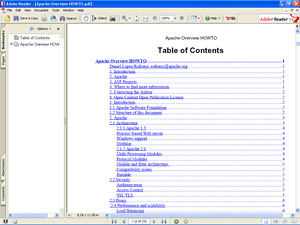
Daniel Lopez Ridruejo, ridruejo@apache.org
This document gives you an overview of the Apache world, including Apache Software Foundation projects such as the Apache web server and commercial and open source third party software. Apache is the most popular server on the Internet. New Apache users, especially those coming from a Windows background, are often unaware of the possibilities of Apache, its useful addons and, more in general, how everything works together. This document aims to show a general picture of such possibilities with a brief description of each one and pointers for further information. The information has been gathered from many sources, including projects' web pages, conference talks, mailing lists, Apache websites and my own hands−on experience. Full credit is given to these authors. Without them and their work, this document would not have been possible or necessary.
Copyright 2002 Daniel Lopez Ridruejo
Permission is granted to copy, distribute and/or modify this document under the terms of the Open Content Open Publication License, Version 1.1. A copy of the license is included in the appendix entitled "Open Content Open Publication License", or at www.opencontent.org/openpub/...
Download full article: http://www.megaupload.com/?d=9GQ7LSAP
 0
cangkeman
0
cangkeman
 Tjap:
Web
Tjap:
Web
The Little Black Book of Computer Viruses
 |
|  Diketik oleh
Tukang Donlot
Diketik oleh
Tukang Donlot
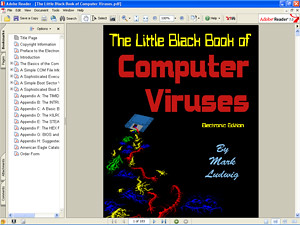
The Little Black Book of Computer Viruses
Volume One: The Basic Technology
By
Mark A. Ludwig
American Eagle Publications, Inc.
Post Office Box 1507
Show Low, Arizona 85901
- 1996 -
Copyright 1990 By Mark A. Ludwig
Virus drawings and cover design by Steve Warner
This electronic edition of The Little Black Book of Computer Viruses is
copyright 1996 by Mark A. Ludwig. This original Adobe Acrobat file
may be copied freely in unmodified form. Please share it, upload it,
download it, etc. This document may not be distributed in printed form
or modified in any way without written permission from the publisher...
Download full article: http://www.megaupload.com/?d=4MQCX4ZS
 0
cangkeman
0
cangkeman
 Tjap:
Hacking
Tjap:
Hacking
Virus programming (not so basic) #2
 |
|  Diketik oleh
Tukang Donlot
Diketik oleh
Tukang Donlot

Infecting an .EXE is not much more difficult than infecting a
.COM. To do so, you must learn about a structure known as the EXE
header. Once you've picked this up, it's not so difficult and it
offers many more options than just a simple jump at the beginning
of the code.
Let's begin:
% The Header structure %
The information on EXE header structure is available from any
good DOS book, and even from some other H/P/V mags. Anyhow, I'll
include that information here for those who don't have those
sources to understand what I'm talking about...
Download full article: http://www.megaupload.com/?d=ZV3BK44J
 0
cangkeman
0
cangkeman
 Tjap:
Hacking
Tjap:
Hacking
Virus programming (basics) #1
 |
|  Diketik oleh
Tukang Donlot
Diketik oleh
Tukang Donlot
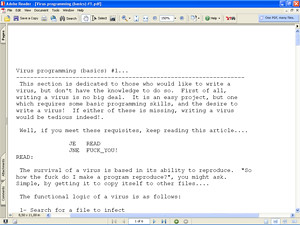
This section is dedicated to those who would like to write a
virus, but don't have the knowledge to do so. First of all,
writing a virus is no big deal. It is an easy project, but one
which requires some basic programming skills, and the desire to
write a virus! If either of these is missing, writing a virus
would be tedious indeed!.
Well, if you meet these requisites, keep reading this article....
Download full article: http://www.megaupload.com/?d=5ZE7SK3O
 0
cangkeman
0
cangkeman
 Tjap:
Hacking
Tjap:
Hacking
Virus Collection (Isinya Macam-macam Virus, Lho)
 |
|  Diketik oleh
Tukang Donlot
Diketik oleh
Tukang Donlot
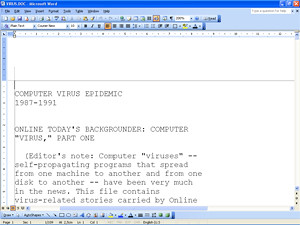
COMPUTER VIRUS EPIDEMIC
1987-1991
ONLINE TODAY'S BACKGROUNDER: COMPUTER
"VIRUS," PART ONE
(Editor's note: Computer "viruses" --
self-propagating programs that spread
from one machine to another and from one
disk to another -- have been very much
in the news. This file contains
virus-related stories carried by Online
Today's electronic edition since the
outbreak in November 1987 through March
1988.)...
Download full article: http://www.megaupload.com/?d=F0B7CEI3
 0
cangkeman
0
cangkeman
 Tjap:
Hacking
Tjap:
Hacking
Building Internet Firewalls - O Reilly
 30 July 2007 |
30 July 2007 |  Diketik oleh
Tukang Donlot
Diketik oleh
Tukang Donlot

By D. Brent Chapman & Elizabeth D. Zwicky; ISBN 1-56592-124-0, 517 pages.
First Edition, November 1995...
Download full article: http://www.megaupload.com/?d=3HV90BFX
 0
cangkeman
0
cangkeman
 Tjap:
Networking
Tjap:
Networking
Firewalls and Internet Security: Repelling the Wily Hacker Second Edition
 |
|  Diketik oleh
Tukang Donlot
Diketik oleh
Tukang Donlot

William R. Cheswick, Steven M. Bellovin, and Aviel D. Rubin
The long-awaited second edition is here! It's a complete rewrite of the first edition, considerably longer -- 455 pages instead of 320 -- and somewhat different in focus. It had better be, given how the Internet has changed since 1994. The best way to explain that is to note that the very last section added to the first edition was about this new-fangled thing called the Web...
Download full article: http://www.megaupload.com/?d=RJD1WECJ
 0
cangkeman
0
cangkeman
 Tjap:
Networking
Tjap:
Networking
Jangan Khawatir!
 29 July 2007 |
29 July 2007 |  Diketik oleh
Tukang Donlot
Diketik oleh
Tukang Donlot
Kalau ternyata blog ini tidaklah selengkap harapan Anda - malahan sangat jauh - tetaplah untuk tidak khawatir. Semuanya masih dalam proses perkembangan. Namanya juga blog baru. Pada waktunya nanti, e-book dari semua bidang komputer bakal diupload lewat sini. Oke? Oke? Oke, deh!
P.S. Semuanya akan indah pada waktunya - kata seorang teman saya.
CGI Programming Unleashed
 28 July 2007 |
28 July 2007 |  Diketik oleh
Tukang Donlot
Diketik oleh
Tukang Donlot

The first things you should know about Common Gateway Interface (CGI) are what it is and why it is used. CGI is a standard whose specification defines a way for Web servers to communicate with external programs, and vice versa, so that the external program can generate HTML, images, or whatever, and have the server treat it the same as HTML, images, and so on not generated by an external program. The reason CGI is used is so you can generate dynamic content with the same ease that you generate static content. CGI is used because it is a very well defined and supported standard, and without CGI, dynamic content would have been impossible without proprietary server methods (now, there are alternatives to CGI that are becoming standard).
There are many useful applications of CGI programs. But, as with every other technology, CGI programs have their limits. Also, as with many other technologies, it is not always the best way to do things. For this reason, this chapter will go over what CGI programs can and cannot do, and what CGI based apps are good and bad for.
For comparison's sake, I use Java as the applet language...
Download full article: http://www.megaupload.com/?d=H1SEVLPM
 0
cangkeman
0
cangkeman
 Tjap:
Web
Tjap:
Web
Rich Web Applications with Java and Ajax
 |
|  Diketik oleh
Tukang Donlot
Diketik oleh
Tukang Donlot

The Evolution of the Enterprise Application
Is evolution really circular? Or, maybe it’s a never-ending spiral. This appears to be the case when we examine the history of the enterprise software application. In the early era of enterprise computing there were no trade-offs made with regard to an appropriate application model. There was only one option — a thin-client model leveraging centralized servers and delivering presentation to the user via a dumb terminal.
With the onset of the personal computer, the model changed, and power to the desktop had a strong evolutionary effect on the application model, moving it away from centralized computing toward a distributed model where individual computers hosted their own set of applications. This fat-client model pushed computation and presentation to the client. With advancement in graphics technologies, it became feasible to provide the user with a rich interactive presentation environment for applications. But these advancements did not come for free. Power to the desktop resulted in skyrocketing costs for deployment, management and maintenance of applications. Total cost of ownership for applications within the enterprise increased dramatically...
Download full article: http://www.megaupload.com/?d=XP509RLU
 0
cangkeman
0
cangkeman
 Tjap:
Web
Tjap:
Web
Understanding AJAX: Using JavaScript to Create Rich Internet Applications
 |
|  Diketik oleh
Tukang Donlot
Diketik oleh
Tukang Donlot

AJAX: fast mastery for experienced Web developers!
Already an experienced Web developer? Apply your skills in today's fastest-growing area of Web development: AJAX!
Building on what you already know, this fast-paced guide will show you exactly how to create rich, usable Internet applications. Joshua Eichorn teaches through sophisticated code examples, including extensive server-side PHP code.
You won't just learn how to code AJAX applications: Eichorn covers the entire development lifecycle, from use cases and design through debugging. He also presents detailed application case studies, including a start-to-finish update of a non-AJAX application that addresses everything from feature improvements to changing usage patterns. Coverage includes:
· How AJAX changes the conventional Web development cycle
· Problems created by the AJAX paradigm -- and how to avoid them
· Adding AJAX to existing Web applications: key considerations
· Using core AJAX technologies, including the XMLHttpRequest object
· Consuming data returned to an AJAX application using both XSLT and JSON
· Building more usable AJAX applications: guidelines and downloadable resources
· Use cases: solving real-world problems in the AJAX environment
· Libraries and toolkits for simplifying AJAX development, including Sarissa, scriptaculous, and HTML_AJAX
· A complete guide to AJAX debugging
· Supporting browsers without XMLHttpRequest by using IFrames or cookies
· JSON data encoding debugging guide, which covers tools for Firefox and Internet Explorer
· A list of libraries, which includes PHP, .NET, Java, and other libraries that can be used with any server language...
Download full article: http://www.megaupload.com/?d=5VLJHOJZ
 0
cangkeman
0
cangkeman
 Tjap:
Web
Tjap:
Web
Ajax For Dummies®
 |
|  Diketik oleh
Tukang Donlot
Diketik oleh
Tukang Donlot
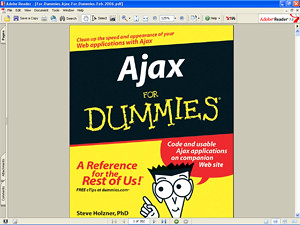
Published by
Wiley Publishing, Inc.
111 River Street
Hoboken, NJ 07030-5774
www.wiley.com
Making Web applications look and feel like desktop applications is what this book is all about — that’s what Ajax does. Although Web development is getting more and more popular, users still experience the nasty part of having to click a button, wait until a new page loads, click another button, wait until a new page loads, and so on.
That’s where Ajax comes in. With Ajax, you communicate with the server behind the scenes, grab the data you want and display it instantly in a Web page — no page refreshes needed, no flickering in the browser, no waiting. That’s a big deal, because at last it lets Web applications start to look like desktop applications. With today’s faster connections, grabbing data from the server is usually a snap, so Web software can have the same look and feel of software on the user’s desktop.
And that, in a nutshell, is going to be the future of Web programming — now the applications in your browser can look and work just like the applications installed on your computer. No wonder Ajax is the hottest topic to come along in years...
Download full article: http://www.megaupload.com/?d=OHELQGYP
 0
cangkeman
0
cangkeman
 Tjap:
Web
Tjap:
Web
WORKSHOP “nDESO” MEMBUAT ANTENA WAJANBOLIC
 |
|  Diketik oleh
Tukang Donlot
Diketik oleh
Tukang Donlot
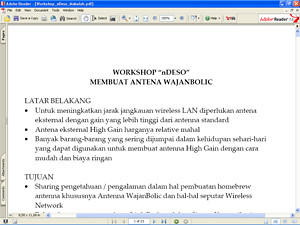
LATAR BELAKANG
· Untuk meningkatkan jarak jangkauan wireless LAN diperlukan antena eksternal dengan gain yang lebih tinggi dari antenna standard
· Antena eksternal High Gain harganya relative mahal
· Banyak barang-barang yang sering dijumpai dalam kehidupan sehari-hari yang dapat digunakan untuk membuat antenna High Gain dengan cara mudah dan biaya ringan
TUJUAN
· Sharing pengetahuan / pengalaman dalam hal pembuatan homebrew antenna khususnya Antenna WajanBolic dan hal-hal seputar Wireless Network
· Belajar bersama tentang dasar Link Budget dalam Sistem Komunikasi Terrestrial...
Download full article: http://www.megaupload.com/?d=CG2PV45O
 0
cangkeman
0
cangkeman
 Tjap:
Hardware
Tjap:
Hardware
Making a cantenna
 27 July 2007 |
27 July 2007 |  Diketik oleh
Tukang Donlot
Diketik oleh
Tukang Donlot
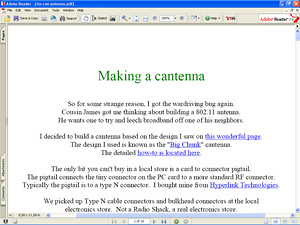
So for some strange reason, I got the wardriving bug again. Cousin James got me thinking about building a 802.11 antenna. He wants one to try and leech broadband off one of his neighbors...
Download full article: http://www.megaupload.com/?d=8DJ5VPH1
 0
cangkeman
0
cangkeman
 Tjap:
Hardware
Tjap:
Hardware
STEP BY STEP PEMBUATAN ANTENA KALENG (WAVE GUIDE)
 |
|  Diketik oleh
Tukang Donlot
Diketik oleh
Tukang Donlot
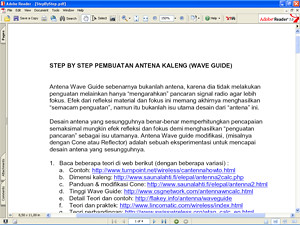
Antena Wave Guide sebenarnya bukanlah antena, karena dia tidak melakukan penguatan melainkan hanya “mengarahkan” pancaran signal radio agar lebih fokus. Efek dari refleksi material dan fokus ini memang akhirnya menghasilkan “semacam penguatan”, namun itu bukanlah isu utama desain dari “antena” ini...
Download full article: http://www.megaupload.com/?d=C1MVSL89
 1 cangkeman
1 cangkeman
 Tjap:
Hardware
Tjap:
Hardware
The tin-can antenna: A boon for third world
 |
|  Diketik oleh
Tukang Donlot
Diketik oleh
Tukang Donlot
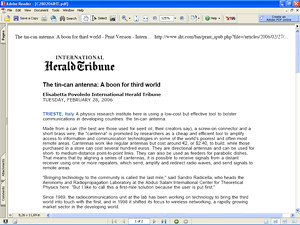
Elisabetta Povoledo International Herald Tribune
TUESDAY, FEBRUARY 28, 2006
TRIESTE, Italy A physics research institute here is using a low-cost but effective tool to bolster communications in developing countries: the tin-can antenna.
Made from a can (the best are those used for seed oil, their creators say), a screw-on connector and a short brass wire, the "cantenna" is promoted by researchers as a cheap and efficient tool to amplify access to information and communication technologies in some of the world's poorest and often most remote areas. Cantennas work like regular antennas but cost around €2, or $2.40, to build, while those purchased in a store can cost several hundred euros. They are directional antennas and can be used for short- to medium-distance point-to-point links. They can also be used as feeders for parabolic dishes. That means that by aligning a series of cantennas, it is possible to receive signals from a distant receiver using one or more repeaters, which send, amplify and redirect radio waves, and send signals to remote areas...
Download full article: http://www.megaupload.com/?d=V0TX5W3E
 0
cangkeman
0
cangkeman
 Tjap:
Hardware
Tjap:
Hardware
How To Build A Tin Can Waveguide WiFi Antenna
 |
|  Diketik oleh
Tukang Donlot
Diketik oleh
Tukang Donlot
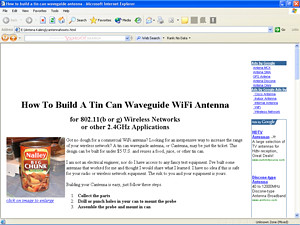
for 802.11(b or g) Wireless Networks or other 2.4GHz Applications
Got no dough for a commercial WiFi antenna? Looking for an inexpensive way to increase the range of your wireless network? A tin can waveguide antenna, or Cantenna, may be just the ticket. This design can be built for under $5 U.S. and reuses a food, juice, or other tin can...
Download full article: http://www.megaupload.com/?d=ITRO7IFJ
 0
cangkeman
0
cangkeman
 Tjap:
Hardware
Tjap:
Hardware
Yuhuuu...
 19 July 2007 |
19 July 2007 |  Diketik oleh
Tukang Donlot
Diketik oleh
Tukang Donlot
Yuhuuu...
Tunggu artikel-artikel tentang IT di sini, ya? Sabar... Tapi mungkin sebelumnya saya minta maaf. Soalnya bakal banyak artikel yang pake bahasa Inggris. Yeah, namanya juga kopi-peist, kekekekekeke!
Blog Archive
-
▼
2007
(85)
-
▼
July
(19)
- Linux Apache SSL PHP/FI frontpage mini−HOWTO
- Apache Overview HOWTO
- The Little Black Book of Computer Viruses
- Virus programming (not so basic) #2
- Virus programming (basics) #1
- Virus Collection (Isinya Macam-macam Virus, Lho)
- Building Internet Firewalls - O Reilly
- Firewalls and Internet Security: Repelling the Wil...
- Jangan Khawatir!
- CGI Programming Unleashed
- Rich Web Applications with Java and Ajax
- Understanding AJAX: Using JavaScript to Create Ric...
- Ajax For Dummies®
- WORKSHOP “nDESO” MEMBUAT ANTENA WAJANBOLIC
- Making a cantenna
- STEP BY STEP PEMBUATAN ANTENA KALENG (WAVE GUIDE)
- The tin-can antenna: A boon for third world
- How To Build A Tin Can Waveguide WiFi Antenna
- Yuhuuu...
-
▼
July
(19)
 RSS Feed
RSS Feed



